Weak pressure of hot water from a geyser: reasons for reduced pressure + cleaning instructions
To bathe in hot water and avoid possible expensive repairs, you need to operate the equipment correctly, and also, for preventative purposes, periodically clean it from accumulated dirt. Scale, clogging, wear of filters - these and other factors can lead to weak pressure of hot water from the gas water heater or the household appliance to completely fail. I wouldn’t want to be left without hot water supply at the most inopportune moment, do you agree?
But what to do in case of low pressure, how to detect the cause and eliminate it? In this article, we will consider in detail possible problems that prevent the normal operation of the water heater, and methods for solving the problem. For clarity, we will supplement the presented material with photos and video recommendations.
The content of the article:
Reasons for low water pressure from the tap
Are you facing the problem of insufficient pressure? Let's figure out what might be causing this situation and how to solve it correctly.
Problem #1 - insufficient pressure in the network
Sometimes problems with weak hot water pressure occur due to instability pipeline pressure. Residents of high-rise buildings especially often face this difficulty.
When the pressure decreases, sensors on the water heater are activated. Not only does the water flow poorly, but its temperature does not rise above 50 °C. Of course, there should be a difference in pressure at the inlet and outlet of the column, but not much.
If the water heater is fully operational, and the reason for poor pressure lies in insufficient pressure in the centralized water supply, then you can influence the situation by installing hydraulic accumulator suitable volume. This solution is ideal for houses and apartments with frequent water supply outages.
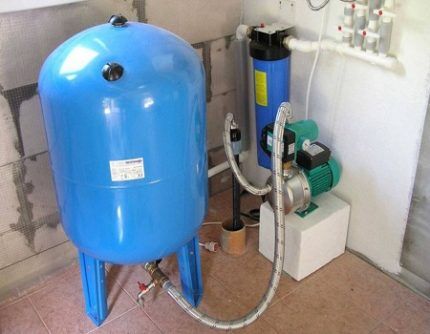
Problem #2 - filter clogged
If the pressure in the water supply system is normal, but water flows poorly from the gas water heater, then you need to look for the reason in the water heater itself. The filter may be clogged or scale has formed.
And sometimes the speaker fails due to its insufficient power. Therefore, experts recommend buying gas inreheaters power from 8 kW or more.
The most common problem with low hot water pressure is a clogged coarse filter. All because of old piping systems that have not seen pipe replacement or repairs for years. Microparticles of various debris come to us along with water through the pipeline. The filter “slows down” them and prevents them from leaking into the gas water heater.
Over time, a lot of debris accumulates and the water pressure becomes worse. Therefore, the mesh needs to be cleaned periodically.
You can find the filter on the water reducer pipe. Looks like a regular mesh. If the water pressure was strong, the filter element could bend and get inside the pipe. The mesh should be removed and washed under running water. For a better effect, you can soak it briefly in a solution of acetic acid.
Problem #3 - scale formation
Over time, as the water heats up, scale forms on the surface of the internal elements of the column. The rate at which deposits form depends on many factors: water hardness, frequency of heating equipment.
Scale in the heat exchanger tubes not only reduces the pressure in the system, but also increases the amount of gas used to heat water.

Limescale deposits can even cause the water heater to break down. Therefore, at the first signs of scale formation, you should cleaning the column.
Signs of scale appearance:
- there is poor hot water pressure at the outlet of the heater;
- after a short heating, the protection (thermal sensor) is triggered;
- the speaker often turns on and off;
- The water takes a long time to heat up.
Remove scale from the heat exchanger using purchased products or solutions specially prepared for this purpose. There are also non-chemical methods to combat limestone deposits.
Method #1 - citric acid + cleaning instructions
When scale has formed and the gas water heater is clogged, not many people know how to clean it if there is no normal water pressure. The best thing to do, of course, is to seek help from professionals. But sometimes there is no time or extra money to call a specialist.
Therefore, many owners independently wash their water heaters to remove limestone deposits. A solution of citric acid is used for these purposes. But this procedure should be performed carefully so as not to damage the parts of the gas device. If you smell gas, you should call emergency services.
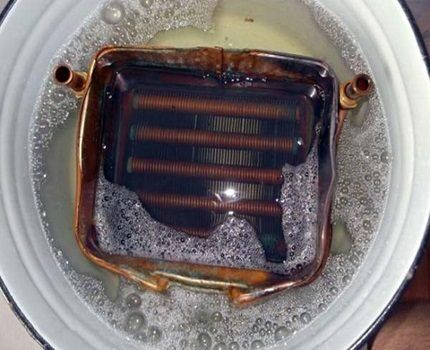
Algorithm for cleaning the column yourself:
- We carry out preparatory work: turn off the water and gas, disconnect the water heater from the network, drain the liquid from the equipment.
- We clean the mesh filter located at the inlet of the receiving unit. The mesh can be washed under normal water pressure. If there are calcium deposits, you need to soak the filter in a citric acid solution.
- As the cleaning work progresses, we check the membrane. If any deformation is detected on the part, we replace it with a new one. On one's own remove the membrane and install it back is not difficult, since the block is mounted using threaded connections.
- We remove the heat exchanger. Do not pull it too hard; you may damage the fastening. If the nuts have soured and are difficult to unscrew, then take “VD-40” or a similar product and apply it to the threaded connections. After 20 minutes you can already try to remove the heat exchanger.
- Soak the heat exchanger in a solution: 200 g of citric acid per 1 liter of water. Pour the resulting product into the radiator and leave it for 10-12 hours.
- We rinse the heat exchanger with water and install it in its place. During the installation of parts, we be sure to check the condition of the sealing gaskets and, if necessary, install new ones.
- We open the water supply and make sure there are no leaks.
- Spread the junction with the gas pipe with soapy water and check for leaks.
- We connect the gas water heater to the electrical network and heat the water.
This cleaning should be done every 2 years. If the water has high hardness levels, then descaling is done more often.
Citric acid is quite popular for cleaning various appliances and household appliances. Thus, it is often used as an effective remedy for cleaning the washing machine.
Method #2 - using phosphoric acid
Cleaning scale using this method requires removing the radiator from the gas water heater. To circulate the product through the radiator, you will need a special device and a concentrate of orthophosphoric acid 7-10%.
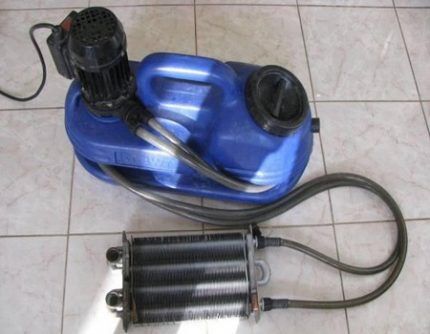
The heat exchanger removed from the column is installed on a flat surface, after which cleaning equipment with a reagent already filled in is connected to it. The connections between the installation and the radiator inlet and outlet must be sealed; they can be insulated with electrical tape.
The descaling procedure lasts about an hour. However, it all depends on how clogged the radiator is; if the deposit layer is too thick, the flushing time may be increased. Afterwards, the heat exchanger should be thoroughly washed to remove any phosphoric acid residues and carefully installed in its place.
Method #3 - descaling with hydrochloric acid
Quick descaling of the column heat exchanger can be done using hydrochloric acid. To do this, take two pieces of hose or pipe with a fitting: one part is connected to the radiator inlet, the second to the outlet. A funnel is attached to the first hose and raised above the level of the water heater. A 3-5% solution of hydrochloric acid is slowly poured into the watering can.
Foam may form during the washing process. The product eats away scale quite quickly; if there is strong pressure at the outlet, it means that the deposits have already dissolved.Be sure to wash with rubber gloves; the acid can injure the skin of your hands.
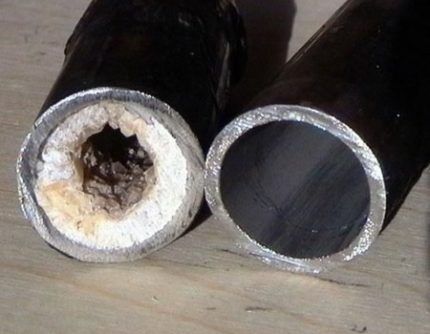
Using hydrochloric and other acids, getting rid of scale in a water heater is quite easy. But you should be aware that such products can destroy metal parts, as well as their welded joints.
Therefore, it is better to wash using special closed-type equipment and use preparations intended for cleaning. Equipment for cleaning geysers is sold in many stores. It supplies working fluid under pressure through the circuit at the required temperature.
During the processing process, the use of hydrochloric acid is alternated with several solutions. This way it is possible to avoid the negative influence of reagents on the metal elements of the water heater. At the same time, various deposits are well removed and corrosion processes are prevented.
Scale can form not only in the radiator, so deposits must be cleared from the entire fluid path. During the cleaning process, you should take into account the material characteristics of the heater parts and components.
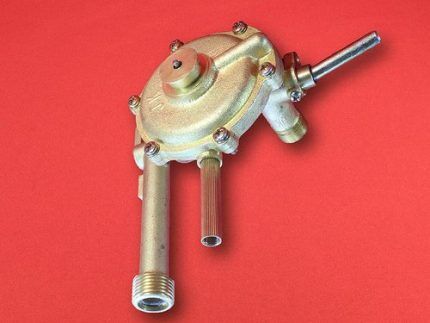
Method #4 - use of electromagnetic technologies
Scaling is cleaned using ultrasound – an electromagnetic scale transducer.
There are several variations of the ultrasonic filter, which differ in power, as well as in the method of generating the magnetic field. The units are capable of protecting a pipeline section up to 2 km long from the formation of deposits.

The electromagnetic transducer should be installed in a section of the incoming water pipe that is free of scale. That is, before starting the magnetic filter for the first time, you should rinse the heat exchanger and clean the water intake unit.
The device will generate magnetic pulses that soften the water, remove deposits and prevent new scale from forming.
Problem #4 - faucet clogged
Poor hot water pressure does not always indicate that the gas water heater is clogged; sometimes the reason lies in the mixer itself. Sometimes debris from the water heater pipes makes its way into the faucet. A blockage can form in a thin rubber hose, filter or other elements.
To normalize the water pressure and fix the problem, you need to disassemble the mixer and wash off the accumulated dirt from the parts.
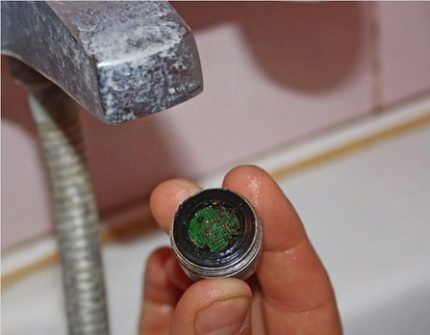
If the hot water pressure in the kitchen is normal, but the flow in the bathroom is weak, it means the filter is clogged with debris. After flushing it, normal pressure will be restored. If the water quality is poor, the gooseneck filter mesh should be cleaned every month.
Due to the constant heating of water by a gas water heater to 70 °C or more, deformation of the rubber gasket in the tap may occur. The warped part will partially block the water flow, which will lead to a decrease in pressure. Therefore, it is impossible to do without replacing the gasket.
Prevention of scale formation in the heat exchanger
To avoid the hassle of dismantling the heat exchanger and descaling it, you should operate correctly geyser.
It is easier to prevent the formation of salt deposits than to get rid of them later.
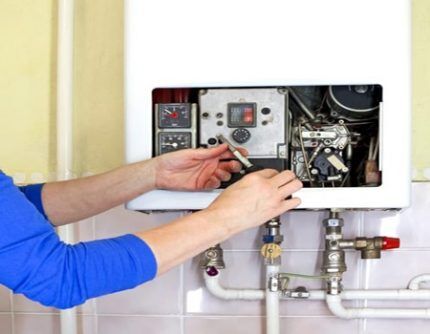
Preventive measures:
- You should swim in water with a temperature of up to +40 °C. This temperature regime is good for health and does not harm the column.
- For washing dishes, a temperature of 45-50 °C will be sufficient. The water will be comfortable for your hands and the fat will dissolve well.
- Washing can also take place at a temperature of 45-50 °C. For severe contamination, you can add another +5 °C.
The process of formation of solid deposits is accelerated by temperature conditions with intense heating up to +80 °C. Scale begins to be deposited even on the perfectly smooth walls of the heat exchanger, and if there is roughness on the surface, then the fastening becomes “reinforced concrete”.
Conclusions and useful video on the topic
Visual instructions for dismantling the coarse filter.
Watch the video to see how to clean a water heater using household chemicals.
Poor hot water pressure from an instantaneous gas heater can occur due to many reasons. The most common is the formation of scale, which appears as a result of prolonged use.You can get rid of it either with the help of expensive purchased products or with solutions of various acids.
It happens that the pressure disappears due to clogged filters of the geyser or mixer. With proper care of equipment and plumbing, problems with low hot water pressure can easily be avoided.
Would you like to supplement the above material with useful comments or point out the reason for the decrease in water pressure that we did not mention in our article? Write your comments in the block below, take part in discussions, express your opinion on one of the issues raised by other site visitors.



